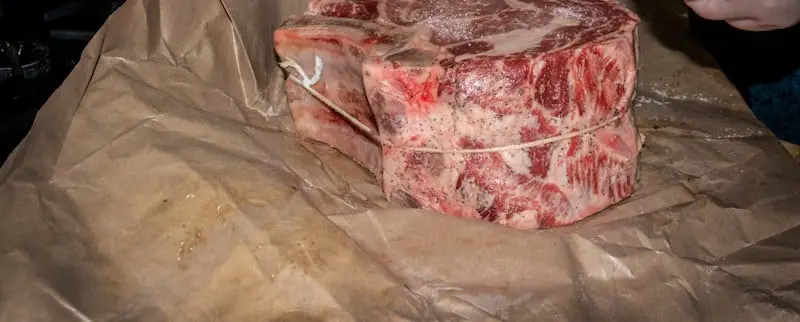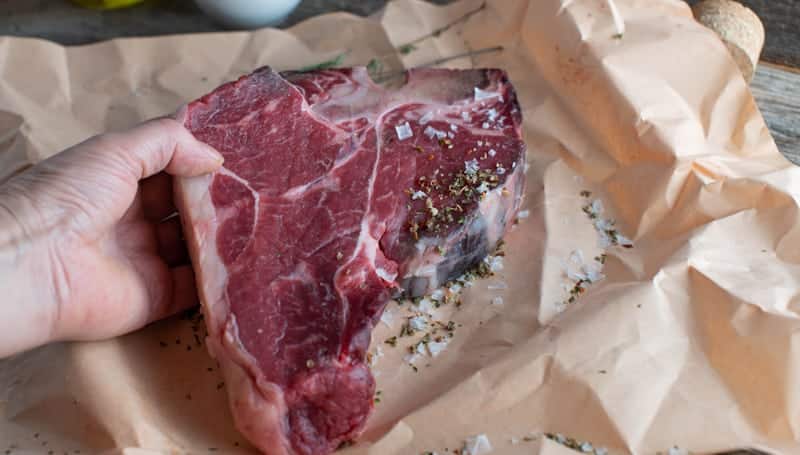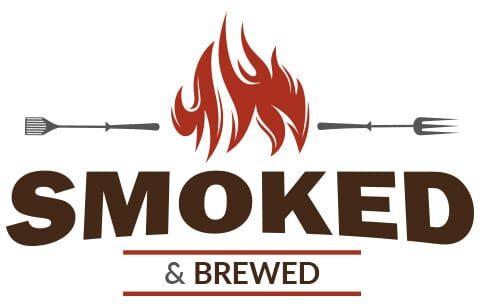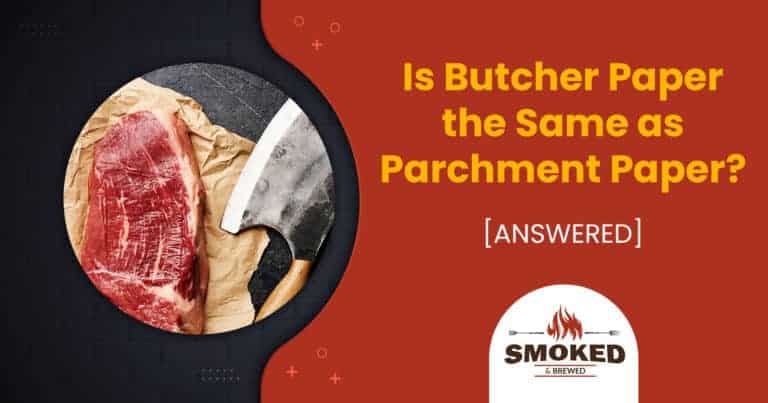Multiple kitchen gadgets help you while you’re cooking at home. You’ll most likely already have what you want or need in your kitchen cupboard. The hard part is knowing when to pick butcher paper over parchment paper.
While butch and parchment paper can be interchangeable in certain situations, using the wrong one can wreak havoc. For grilling, parchment paper trumps butcher paper by a long shot. The temperature threshold of parchment paper is better suited to withstanding indirect heat from the chiller part of the grill. Butcher paper, on the other hand, tends to catch fire.
There are multiple papers and sheets for wrapping that we use in different processes in cooking. These include foil, wax paper, parchment paper, plastic wrap and butch paper. If you didn’t know, all of these papers have different uses for various cooking stages, thanks to their unique properties. Our article should help clarify the variances between butcher and parchment paper so that you know which paper to use appropriately.

Butcher Paper
The butcher paper is simply a thicker version of the standard kraft paper. Like other paper goods, butcher paper uses wood-treated fibers, giving it its durability and robustness. The paper is typically white, but you can also find it pink or brown, either in rolls or pre-cut paper sheets.
The brown kind of paper is the most commonly used type. However, you can also use pink or peach-toned paper, which is now growing in popularity.
It is worth remembering that butcher paper receives FDA approval and authorization for its food-grade wood fibers. Therefore, the pink version of butcher paper does not receive bleaching and is the more organic paper option. Brands bleach butch paper to make it white. It’s also important to remember that butcher and freezer paper aren’t interchangeable, so you can’t substitute them.
What Are Some Uses of Butcher Paper?
The paper is excellent for gift-wrapping, designing gift tags, and decorating cakes. Additionally, it works well for wrapping different things since it won’t tear easily. You can even use butcher paper to maintain the freshness of certain vegetables like celery.
While butcher paper is versatile and multipurpose, keep in mind that it can catch fire and burn on exposure to high heat or direct flame. The most common use of butcher paper is grilling meats in the cooking sector.
In the right situation, wrapping more significant cuts of meat using butcher paper is a convenient option. Butch paper is also used for smoking meat since the low smoke temperatures mean that the paper won’t catch fire or smoke. While it isn’t the latest cooking trend, using butch paper for smoking has recently garnered more popularity.
[amalinkspro_table id=”626″ new-window=”on” nofollow=”on” addtocart=”off” /]
What Are Some Uses of Pink Butcher Paper?
This specific paper type is ideal for smoking since the temperature isn’t hot enough to cause burning so that the paper won’t catch fire. However, I don’t condone grilling with butcher paper, whether directly or indirectly, on heat.
Parchment paper works better than butcher paper to make small packs of broiled foods. The drawback of pink butcher paper with raw meat is that the paper absorbs the meat juices, which causes the meat to dry.
Other Uses
You can use butcher paper for other things besides meat wrapping. These include gift wrapping, craft designs, and scrapbooking. In addition, you should use butcher paper for anything where you require a durable and absorbent material.
Parchment Paper
This paper is a slim, lightweight paper ideal for use while you’re barbecuing food. Thanks to its thinness, parchment paper maintains its durability. It typically comes in pre-cut rolls or squares at your local grocery stores and even online.
Similar to butch paper, parchment comes from wood. Manufacturers also gelatinize the wood’s external cellulose. This process improves the paper’s thermal capabilities and minimizes the surface density to prevent food adhesion.
Parchment paper tends to be slightly less porous than butcher paper following this process. Therefore, it might retain some fluid instead of absorbing water from the food. That said, it does allow some evaporation so that your meat has a nice texture.
Parchment Paper and Barbecue
Parchment paper is a commonly used product in the baking community but not a standard accessory while smoking or grilling. Instead, people prefer butcher over parchment paper for barbecues and outdoor events.
That isn’t very pleasant since parchment paper can be an excellent alternative for outdoor cooking. Furthermore, outdoor cooks poorly understand the paper’s use, so parchment paper wastes its potential.
You can utilize parchment paper while broiling or barbecuing, although you must avoid direct flames since the paper can burn. You can even use paper for grilling and smoking. First, however, it can help verify a parchment paper’s temperature rating. Uncoated paper can withstand up to 400 degrees F.
Wrap your meats in parchment paper before adding them to your smoker. In that way, most of the fluid evaporates to leave some bark. So, the paper keeps at higher temperatures than butcher paper. Putting parchment directly over a fire may result in burning at high temperatures. Even so, it’s still safe over an indirect heat source.
Always put the parchment packed meats on the cooler side of the BBQ, at a distance from the burning embers. The paper can’t smoke or burn but does have a discoloration tendency. Covering a giant cut of meat like a steak or brisket can take multiple sheets, but it’s worth it to retain the moisture and texture.
What Are Some Other Uses?
Parchment paper has other uses outside of cooking. Here are a few examples:
- You can use parchment paper to make individual food packages.
- Parchment paper is excellent for baking since it does not stick to any pans. It also works for pie crusts, cookies, cakes, bread, and muffins.
- It also acts as a cookie sheet lining for baking multiple cookies simultaneously.
- Parchment paper can act as a cake tin lining as well. Cut out any additional parchment paper after baking.
Is Parchment Paper the Same as Butcher Paper?
Since the two papers are similar, differentiating between them can be confusing. It depends on how you cook and the type of outcome you’d like. So, are they the same? Not really. Butcher paper is typically more permeable, porous, and thicker than parchment paper. The temperature threshold of the former is also lower than the latter.
Parchment Paper vs Butcher Paper
For grilling, parchment paper trumps butcher paper by a long shot. The temperature threshold of parchment paper is better suited to withstanding indirect heat from the chiller part of the grill. Butcher paper, on the other hand, tends to catch fire.
Pricing is also an essential criterion for consideration. In that regard, you’ll have to compare the prices per unit length of both papers. Typically, pink butcher paper is costlier than parchment paper, although it is less expensive overall.
AA paper is affordable, but a roll of parchment paper can probably cost a little less than the same quantity of peach butcher paper. Meanwhile, white and brown butcher papers are significantly cheaper. However, the price difference is close enough to produce a tie in this criterion. Therefore, bulk buying can help you save considerable money regardless of which paper you pick.
 Can I Use Parchment Paper Instead of Butcher Paper?
Can I Use Parchment Paper Instead of Butcher Paper?
The short answer is yes! Both butcher and parchment paper cost almost the same, precisely when buying bulk rolls. Even so, you still have to consider some things before choosing one over the other:
- Parchment paper doesn’t protect against dampness, oiliness and odors.
- You can reuse parchment paper after a wash.
- Parchment paper can warp easily.
Final Words
There you have it. Hopefully, this article helps you understand the uses of both butcher and parchment papers for your future cooking needs.
Scot has loved smoking food in his free time for the last few years. Each major holiday or off-weekend, Scot spends days testing and prepping new recipes for perfection.

